It’s funny how things happen in life. A few months ago I was wondering whatever became of Renwal. I had built some of kits back in the 1960s, like an Army wrecker/recovery truck, and thought how the company wrote on its box tops that the kits were right from the blueprints.
Then in the last few months some word started going around that Revell was releasing some Renwal kits and about a week ago one landed on my lap for me to write an in-box review. Holy cow, what a landing! It was the 1/32 scale kit of the U.S. Army’s Atomic Cannon. Although the box top doesn’t say it, the cannon was technically called the M-65.
However, what the box top does tell you some other things: the model has “no show” connections (that’s good), it’s all plastic (great, I don’t like vinyl tires), seven figures, more than 300 parts and besides the big cannon, you’re getting its two 50-ton transporters! All this at 1/32 scale and considering the real thing measured about 84 feet, you’re going to have a huge model on your hands when done--a few inches short of a yard long and weighing, I’m guessing here, about a few pounds. Small wonder this kit requires a 4-½-inch deep box measuring 16 x 21-½ inches across its top and weighing three to four pounds with the kit in it.
The Real Thing
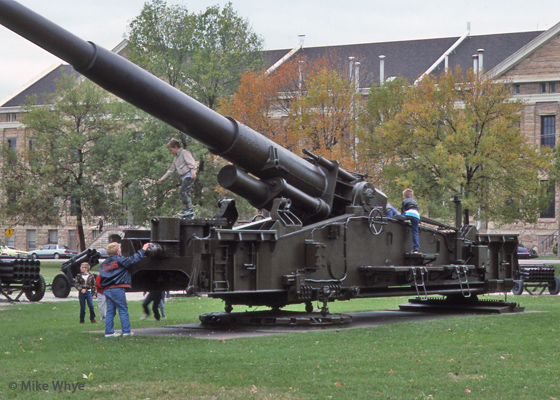
Before discussing the model, here’s a look at the real things--at least 20 of them, manufactured in two arsenals in New York and Massachusetts after the first was designed and made at the Picatinny Arsenal in New Jersey, and it was that one that fired the one and only atomic artillery shell. That particular 280mm shell carried a 15-kiloton W-9 warhead which some said equaled the power of the Hiroshima bomb although it came in three yields, the largest of which was said to require the gun to fire it 18 miles so the gun and crew would be safe. The conventional 600-pound 280mm shell was called the T-124.
Design of the M-65 began in 1949 as the T-131 and was largely the result of one man, Robert Schwartz, who drew up the plans for the 280mm gun as both stationary and mobile units. Eventually the Army settled on the mobile unit which required the use of two 375-horsepower transporters, called prime movers, one ahead of the 94,000-pound (42,582 kg) gun carriage and the other behind.
The front transporter, called the T-249, weighed 37,950 pounds (17,191 kg) while the rear one, called the M-250, weighed 35,910 pounds (16,267 kg). The transporters were made by the Kenworth Truck Company and each had a 6-cylinder engine. They could reach a top speed of 45 mph although it was reported they towed the cannon only up to 30 mph on paved roads. They could also traverse unpaved roads as well.
The gun and its carriage weighed 94,000 pounds (42,582 kg) and was 38 feet, 5 inches (11.7m) long.
Various sources say it could be set up for firing between 7 to 12 minutes. Its range was reported to be 20 miles with an accuracy of 20 yards. However, a soldier who worked with the guns said the maximum range was actually 35 miles.
One M-65 was paraded through the streets of Washington, D.C. during the festivities of President Dwight D. Eisenhower’s inauguration. Otherwise, the M-65s were deployed in West Germany and on Okinawa. The M-65s were never used in combat and were retired from service in 1963. They were deployed in pairs and were accompanied by ammunition-carrying vehicles and a crew of 22 soldiers.
Once set up, the cannon could be maneuvered hydraulically or manually although the rammer operated only hydraulically. It was said to be fired electronically although one person said it could be fired with a lanyard as with other large cannon.
The sole firing of an atomic shell occurred on May 25, 1953 as one of a series of nuclear weapon tests called Operation UPSHOT-KNOTHOLE. The M-65 fired its shell at a target 7 miles away, in a region known as Frenchman Flats at the Nevada Proving Ground, and 19 seconds later the shell exploded 524 feet above the ground. Of the 80 W-9 warheads made, this was the only one fired.
All but eight of the M-65s were scrapped. The remaining ones are on display near Ft. Riley, Kansas; Rock Island Arsenal in Rock Island, Illinois; U.S. Army Ordnance Museum at Aberdeen, Maryland (this one still has its transporters attached to the gun carriage); Virginia War Museum in Newport News, Virginia; Yuma Proving Ground in Yuma, Arizona; Watervliet Arsenal Museum in Watervliet, New York; National Museum of Nuclear Science and History in Albuquerque, New Mexico; and Ft. Sill Museum, Ft. Sill, Oklahoma which has the cannon that fired the atomic shell (and was nicknamed “Atomic Annie”).
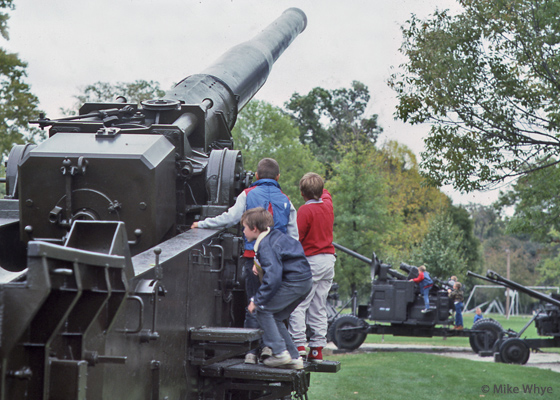
If you wonder how the M-65 compared to the German rail guns of WWII, the most famous of the German guns were the identical Robert and Leopold, known respectively as Anzio Annie and Anzio Express by the Allies, note that the 283mm German guns were transported only on railroads. With their carriages, these guns were 105 feet long, weighed 218 tons and had a range of 40 miles.
To see numerous photos of the M-65, simply Google “Atomic Cannon M-65.” An excellent 10-½-minute video of the atomic shot shows the cannon being transported to the test site (actually, two M-65s were driven to the site) through Las Vegas and out into the desert, being set up, loaded and fired. A picture of the atomic shell shows its details.
References:
https://everything2.com/title/M65+Atomic+Cannon
https://www.globalsecurity.org/military/systems/ground/m65.htm
https://everything2.com/title/M65+Atomic+Cannon
https://www.theatomiccannon.com/history
What’s in the Box
When you open the box which has a heavy reinforced cardboard bottom, you’ll find all the pieces in eight sealed plastic bags. That’s good because in the box I opened, some pieces had separated from the sprues and when you handle the sprues, some more pieces will easily fall away from the sprues, their connection points are that thin. All the plastic is medium gray styrene plastic. After awhile it dawned on me the kit has no clear pieces to represent the windows of the transporters so get yourself a sheet of clear plastic to make those; I would think a sheet measuring 4x5 inches will be all you will need.
Eight sprues hold all the pieces of the kit (excepting those which had separated, as mentioned). I didn’t count the pieces but I’ll trust the claim on the box top that more than 300 pieces are in the kit. I had thought that because the kit was originally made in 1957, a lot of flash would be all over the pieces. Not so on the pieces and only a little on the sprue trees themselves. The pieces are well made and crisp--as evidenced by the screens of platforms that the gun crew is to stand on.
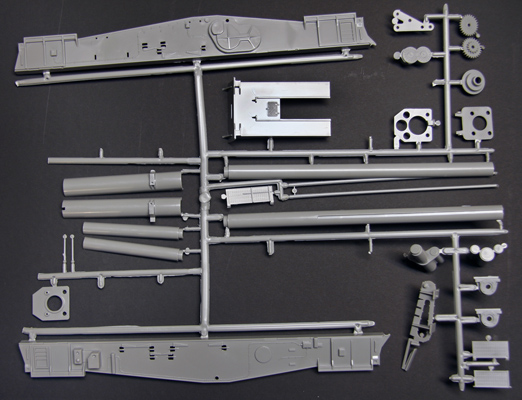
While injection and ejection marks abound, it looks like the majority of those will be hidden once the model is assembled. The only marks to worry about are those on the undersides of the platforms that fold up alongside the long gun carriage frames--but they can be hidden by simply positioning them to the marks either are on the bottom if the platforms are deployed horizontally or up against the gun carriage frames if the platforms are stowed upright. Part numbers are raised and often hard to find and it appears they won’t be seen when you’re done building the model.
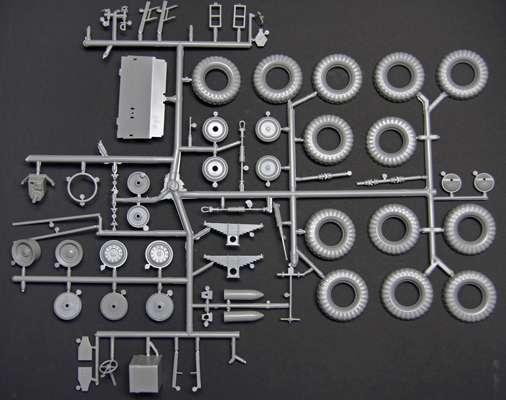
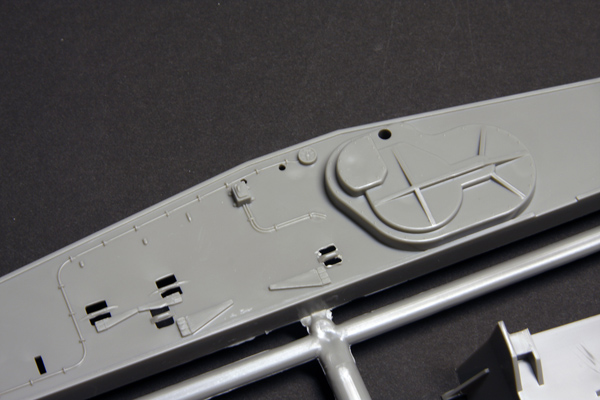
The few panel lines are thin raised lines and the few rivets that exist are crisp although I have noticed that the rivets on front end of the real barrel cradle are missing on the corresponding parts (parts 110 and 111) of the model. Overall, from what I have seen of the M-65 I crawled over at the Rock Island Arsenal and photos of other M-65s, the atomic cannon weren’t busting with lots of rivets, welds, seams and panel lines. In other words, they were pretty clean-looking items. And since the model is similarly clean, I’d say that Renwal did its research well.
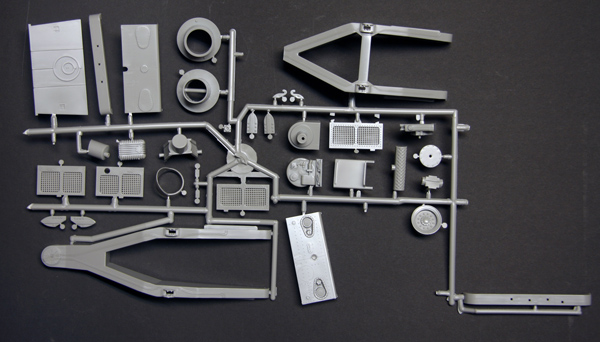
Some areas could use some improvement, particularly the interiors of the transporter cabs; they are very very basic and their doors are molded shut with no interior detail on them. So if you want to open them, you have some work ahead of you. Something else about the transporters--the kit has them equipped with ring-mounted .50-caliber machineguns, much like those seen on the M-26 transporters. However, there are no holes in the roofs of the M-65’s transporters (are we to believe the gunners sat cross-legged atop the cabs of the transporters while they fired the machine guns?) so if you want to use those ring-mounted machine-guns, again, you’ll have some cutting to do but note that the vast majority of photos of the transporters do not show them with the gun-mount rings so modeling them sans guns is an easy way to handle this situation (and since the roofs do not have locator holes for the gun-mount rings, there are no holes to be filled!).
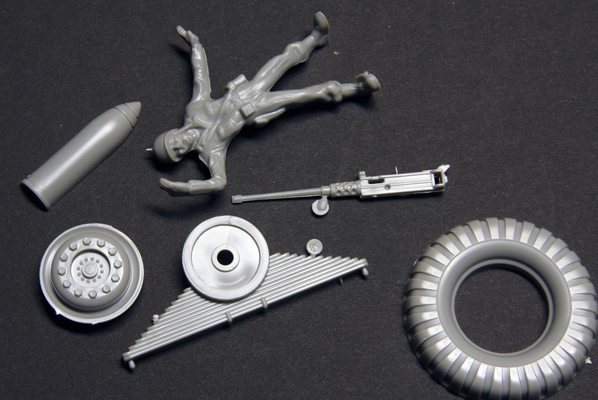
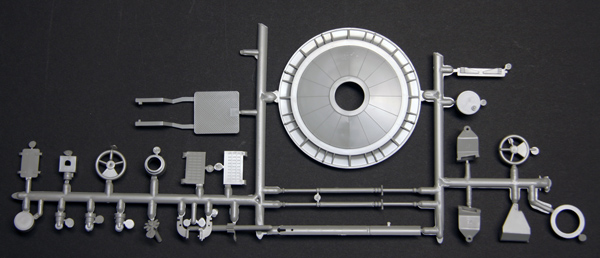
The breech block is molded shut--bummer, but I imagine some super-detailers will have a go at modeling that in an open position. Similarly, the rifling which can be easily seen at the end of the 280mm barrel in real life isn’t shown on the model; if you want those, get your finest scribers ready to do some serious work. Finally, as with so many models of tanks and artillery, the six-parts of the long gun barrel are molded in halves which means some work will be necessary on the seams.
You’ll also have to clean up the seams on the 12 tires. Because the tires don’t have locator pins, note on the instructions how the tires’ treads line up in an alternating pattern.
Among the few shortcomings are the moldings are the crew figures--they’re very soft and sort of lumpy. They definitely take a person back to the early days of plastic models when many figures were like that. The expression on one soldier’s face is one of wide-mouthed horror--an editorial by someone at Renwal about the use of atomic weapons? I dunno. I would use figures from elsewhere if you want to display any near this model.
Instructions and Decals
The 16-page instruction book is good and is very straight-forward about what goes where, what’s to be glued (or not) and what’s to be painted what color. From what I see, you’ll need primarily three colors of paint--aluminum for some recoil pins, traversing wheels and a few rails, black for the tires and olive drab for everything else. Put the airbrush aside--this kit is a prime target for rattle paint cans. The kit has few decals--the yellow stripes across the transporters’ bumpers and the typical white stars and ID numbers for the transporters and the gun carriage. If you want to paint the two artillery shells accurately, refer to the video I mentioned at the end of the section about the real M-65s.
Conclusion
Overall, this is a very simple kit despite having a few hundred parts. It should go together well with a minimum of fuss. The one thing it will do is take you back to the early years of modeling and for some of us that will be quite a trip.
The Atomic Cannon by Renwal (actually Revell now) retails for $56.99. Our thanks to Revell for sending this in for review.